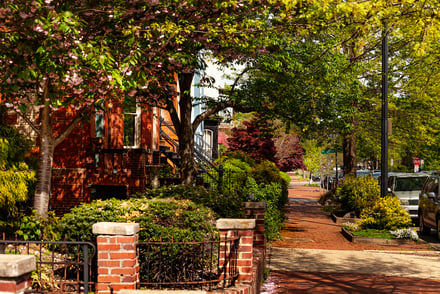Your chimney is more than just a silent black hole of mystery. A chimney performs a number of vital functions for the safety and comfort of your home. A simple outward appearance doesn't tell the whole story of how a chimney is built and what it takes to ensure its safe and efficient performance.
Your brick chimney is constantly exposed to all types of weather, and deterioration can pose significant hazards. Water is the biggest troublemaker. In addition to age, improper planning, poor construction, or neglected maintenance can cause wear, water leaks and extensive, costly repairs. So how, exactly, does water impact your brick chimney, and what can you do to protect it?
Water Penetration
Your brick chimney is likely composed of some combination of mortar, concrete, concrete block, stone, flue tile, cast iron, steel and of course, brick. Of these materials, all but stone can become the victim of significant water damage. Masonry materials wear and crack when exposed to repeated freezing and thawing processes, allowing water to penetrate your chimney structure and cause further wear, like rust and erosion.
Water penetration can cause interior and exterior damage to your brick chimney, and your home, including:
- Chimney settlement
- Clogged clean-out area
- Collapsed hearth support
- Cracked or deteriorated flue lining system
- Decayed exterior mortar
- Deteriorated central heating system
- Deteriorated metal or masonry firebox assemblies
- Rotting adjacent wood and ruined wall coverings
- Rusted damper assemblies
- Rusted fireplace accessories and glass doors
- Stained chimney exterior
- Tilted or collapsed chimney structure
- Water stained walls and ceiling
Therefore, your brick chimney should be protected from the effects of water penetration.
Preserving and Protecting Your Brick Chimney
Ask a professional to assess any current damage to your brick chimney and have it repaired before applying any protective measures. Of course, repairing damaged portions of your chimney is an important protective step in itself. If your home was built in the early 20th century or before, eroded mortar should be replaced with tuckpointing to preserve and protect the original structure in the way it was designed to function.
If your home is constructed where the chimney is located on the low side of the roof, this can cause an excessive amount of water run-off to be directed against the chimney, causing incredible erosion. A professional will install a water deflector, often called a cricket, to afford protection against water leaks and erosion. Crickets are usually recommended on steep roofs and to protect chimneys that are over 30 inches wide.
Other measures can be taken to protect your brick chimney from weather wear and water intrusion, including installing a chimney cap, flashing, repairing or replacing the chimney crown (sometimes called a wash) and by always repairing eroded mortar joints. If you choose to use a waterproofing agent on your brick chimney, always be sure it is vapor permeable to allow the chimney to dry out while blocking moisture intrusion.
If you see obvious signs of deterioration or want a more professional eye to evaluate the condition of your brick chimney, especially on an older masonry building, call us at Renaissance Development to schedule an appointment and get a free quote for services.
1/23/20 1:54 PM


